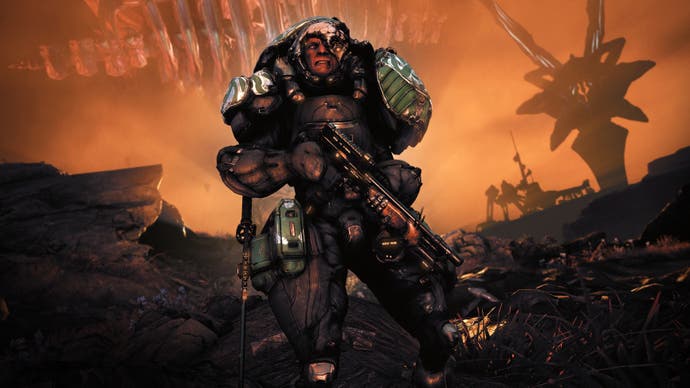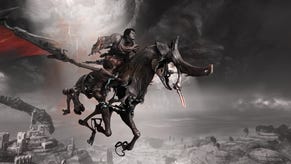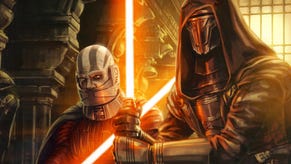Digital Extremes on Warframe's "Infinity War" moment as its biggest story expansion yet approaches
The New War arrives next week.
The New War is an end of sorts; not a definitive end - Warframe's continuing status as an enormously successful free-to-play live service shooter does rather dictate that - but an end to a chapter that's been almost eight years in the making.
The New War, for the uninitiated, is a three-act slab of strictly single-player, heavily cinematic sci-fi adventure telling the story of a massive Sentient invasion from the perspectives of multiple playable characters - including a Grineer Lancer called Kahl-175, Corpus engineer Veso, and Conclave Master Teshin. It's also a culmination of - and, in many ways, a celebration of - every major narrative arc and mechanical addition Digital Extremes has brought to the game thus far, laying the groundwork for new adventures to come.
Or as Digital Extremes' live operations and community director Rebecca Ford puts it to Eurogamer, "It's kind of like we're releasing our Infinity War... we're getting to the point where everything we've done since 2013, 14, 15 has been leading to this moment. It's the finale of sorts for the story we've given you so far about who you are".
"We don't tell players the truth about Warframe until they reach [acclaimed story quest] The Second Dream," Ford elaborates, "which for some players is 100 hours into the game. The New War takes everything The Second Dream introduces and concludes the chapter in a way that you'll know the stakes of the universe. And you'll know what you'll need to do next. It's not the end of Warframe's story, it's a way for you to move on to what's next with closure."
It's also an event Warframe fans have been anticipating for a long time, with Digital Extremes initially teasing The New War all the way back in 2018. "The truth is," Ford admits, "we're kind of a year behind. We would have liked to start 2020 off with The New War in the form you're going to play it this December. But sometimes you get a pandemic while you're making things and decide you can't do it. You decide it's not possible, logistically; it's not possible from a safety perspective; it's not possible to use the studio at all because we're not allowed in the building. There's a lot of reasons we had to say, 'No, we need to change tracks here'".
"Having said that," Ford continues, "the track we changed to, which originally we didn't know if it would connect to The New War, is now a part of The New War. So ultimately, it got better because of the delay in terms of the scope and the story, and there's things in it that wouldn't have been if we released it in 2020. And so now we're in a situation where we've taken the stuff we released, and made it matter in the purposes of the quest, in setting everything up."
And as anyone who's been following Warframe's development over the last few years will know, that 'stuff' encompasses an enormous number of features. "The New War touches the open worlds we added," Ford continues, "it touches [Warframe's deep-space combat component] railjack, it touches on NPCs we added, and it touches on other systems we introduced around our development timelines. So it wouldn't be a stretch to say everything we've released in Warframe that's been a major update has a role to play in The New War."
Indeed, for those players still comparatively early in their Warframe adventure - and I count myself in these ranks, with 'only' a hundred or so hours under my belt - the sheer scale and ambition of The New War might come as a surprise. There's the obligatory cinematic bombast most would likely expect at this climatic point in Warframe's story - Digital Extremes demoed a frantic moment of deep space warfare during its press event - but it finds time for some very different, significantly more low-key moments too.
One demoed sequence in particular - offering a dramatic shift in tone and form which I won't spoil here - completely caught me off-guard. When I tell Ford this she jokes, "I have to laugh. I have to imagine you came to that press event and probably thought you were in the wrong game... but I think it's a good reflection of what Warframe has become."
"We started off making a free-to-play action game with tonnes of cool sci-fi stuff," Ford explains, "then we started to realise it was working." That success gave the team both the drive and the opportunity to take Warframe into more ambitious territory - "to make it more than just an action-RPG", as Ford puts it - and it's here it began to find its story.
"There's a lot of ways you can approach storytelling in video games," Ford continues, "that's the most obvious statement I could ever make. But we wanted it to be as personal as we could possibly make it to directly contradict the world we had built in its most core gameplay form - because there's no real story when you're going in and killing mobs, doing your horde modes, doing all these things... But what if all that came from something very personal?".
"And that's how it all started with The Second Dream," recalls Ford. "We turned it into a very, very personal journey... and for players waiting for The New War, they know what it means, they know what the stakes are. The world is in a very specific state with very, very specific consequences that we're taking very seriously. We're earning ourselves moments of darker tones, serious content matter, all for the purposes of making that personal story."
"In a lot of ways," Ford adds, "the content you're still playing through in that early game is from a time when we had a smaller team with smaller tools. It's kind of interesting to be able to use the quests as a way to reflect on the team's competencies in making content and the team size.
"For The Second Dream [released in 2015], we had the size and scope for some cinematics... and I think 10 minutes of original music in a medley of sorts there. And now we're in 2021, we have 70 minutes of music, we have a multitude of increased cinematic scope and scale. And it reflects the team size, team competencies, team confidence - like, 'We could do this, we shouldn't be afraid to take risks because look at how it paid off back in 2015'."
Some of these learnings have now started to bleed back through the years; last August saw Digital Extremes revisiting Warframe's introductory mission - which structurally had remained largely untouched since the game's launch back in 2013 - giving it a considerably more cinematic, emotionally impactful overhaul that establishes the stakes of Warframe's story in more immediately engaging ways. And it's something the team is already looking to do more of, albeit with ambitions that go beyond simply refreshing older quests.
"We do want to have a moment of 2021 quality early on", explains Ford. "I think the way to do it is in the facets of explaining a system, to emphasise the complexities of the world and the game, but to do it in more than a text menu, which is probably what you're enduring right now - read, retain, then move on to the next thing. Whereas what if we presented it in a way that had a quality bar and an emotional reasoning for it all?".
For all the evident excitement around Warframe's The New War - which Digital Extremes has variously called its "biggest narrative expansion so far" and the "most ambitious thing we've done" - it'd be remiss not to mention the barrier of entry. As the culmination of almost eight years of story content, there's a long list of pre-requisites players will need to complete before they're finally in a position to experience the bravado spectacle of The New War themselves.
It's a not-insignificant time investment - by Digital Extremes' reckoning, it'll take newcomers around 30 hours to reach The New War, assuming they don't get mercilessly sidetracked along the way - and I ask Ford why she believes it's one players should make. "I think if you commit to playing Warframe's story," she says after some thought, "you'll experience a narrative unlike any other in a game that's unlike any other. I think it's incredibly unique.
"It's authentic, because we're doing the story we want to tell and we're taking the time to do it. It doesn't hesitate to be weird and original in a landscape where players might be looking to find something that's incredibly wacky - but ultimately it will make you feel something too. I think the feeling behind everything we're doing has always been to make it as human as we can make it in a visual setting that couldn't be further from human."
By Digital Extremes' own admission, The New War is an end of sorts, so the question inevitably becomes, where does it go from here? One thing on the horizon is the delayed Duviri Paradox update - Warframe's fourth open-world expansion, first announced at Tennocon 2019 for a planned 2020 release - as well as the long-awaited arrival of cross-play and cross-saves, originally planned for this year but now due in 2022.
Ford says the studio is "very excited" about the internal prototypes it has up and running for cross-play and cross-saves, "but we need ridiculous testing. And we need ridiculous attention to detail because it's a free-to-play game. And there's economic consequences to everything once cross-platform hits. So we need to be very, very, very detail oriented in how it all works."
Before all that, though, there's The New War, and after its long road to release, Ford says she's simply looking forward to seeing how it's received by fans. That moment finally arrives on 15th December, when Warframe's The New War update launches on all platforms.










